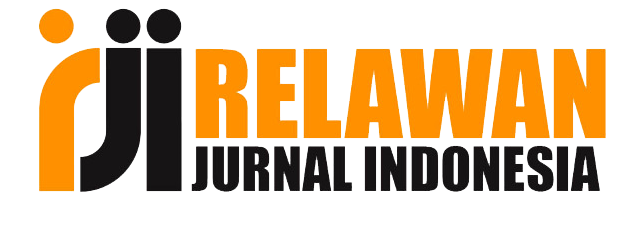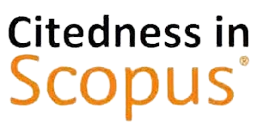Submissions
Submission Preparation Checklist
As part of the submission process, authors are required to check off their submission's compliance with all of the following items, and submissions may be returned to authors that do not adhere to these guidelines.- The submission has not been previously published, nor is it before another journal for consideration (or an explanation has been provided in Comments to the Editor).
- The submission file is in OpenOffice, Microsoft Word, RTF, or WordPerfect document file format.
- Where available, URLs for the references have been provided.
- The text is single-spaced; uses a 12-point font; employs italics, rather than underlining (except with URL addresses); and all illustrations, figures, and tables are placed within the text at the appropriate points, rather than at the end.
- The text adheres to the stylistic and bibliographic requirements outlined in the Author Guidelines, which is found in About the Journal.
- If submitting to a peer-reviewed section of the journal, the instructions in Ensuring a Blind Review have been followed.
Author Guidelines
-
Submission
Manuscripts should be submitted by one of the authors of the manuscript through the Online Submission of this journal. Regardless of the source of the word-processing tool, only Word (.doc, .docx) files can be submitted.
Submission by anyone other than one of the authors will not be accepted. The submitting author (corresponding author) takes responsibility for the paper during submission and peer review. Should the author have some technical reason, the author can contact the journal editor via email (j-reall@unisma.ac.id) for support.
Procedure
Submit your article electronically via the J-ReaLL Submissions link. If you are not yet registered as a user of the publication server, you need to register first as a new user. The details procedure as follows:
- Go to the J-ReaLL website at https://riset.unisma.ac.id/index.php/JREALL/index
- Click the Submissions button on the bar, then simply click Register
- Fill out the given author Profile (Given Name, Family Name, Affiliation, Country, and Phone). Then fill out the given author Login (Email, Username, Password, and Repeated Password).
- Tick the all three given statements whenever author agree on the collected and stored data according to the privacy statement, agree to be notified of new publications and announcements, agree to be contacted as reviewer to the journal.
- Last, indicate the author is not a robot by ticking the reCAPTCHA button, and click register. Once you have completed the registration section, you are able to do article submission via Login
Terms of submission
Manuscripts must be submitted on the understanding that they have not been published elsewhere and are not currently under consideration by another journal. The corresponding author is responsible for ensuring that the article’s publication is an original publication that has been approved by all coauthors.
Authors must strictly follow the submission guidelines of the journal. Submissions that do not adhere to the guidelines provided will be REJECTED/RETURNED FOR CORRECTIONS. Please submit your paper through the Online Submission of this journal. You can use the Online Submission Guidelines for access to the Open Journal Systems (OJS).
All manuscripts submitted for publication in this journal undergo a thorough plagiarism check using Turnitin software. If plagiarism is detected, the authors will receive a notification and will be asked to revise the content or include appropriate citations. If the paper similarity index is less than 15%, the manuscript will be eligible for review and publication.
Linguistic style
The publication is in English. Published manuscripts should adhere to rigorous academic writing standards. If English is not your first language, it is recommended to have your manuscript reviewed, edited, and proofread by a native English speaker (or other English experts) before submitting it.
Manuscript format
The Journal of Research on English and Language Learning (J-ReaLL) follows the APA guidelines (APA Manual, 7th edition)
Carefully read and follow the Author Guidelines as follows:
General Requirements for publication
- Manuscripts submitted to J-REaLL should be research-based papers which have not been published or are under consideration elsewhere.
- Manuscripts must be in English. It should be typed in MS Word doc. format; using 12-pt Garamond font; top, left, bottom, and right margins are 2.4 cm, 2.5 cm, 2.7 cm, and 2 cm; single-spaced on A4-sized paper; length: between 4,000 to 8,000 words (EXCLUDING abstract, references, and appendices).
- The manuscript will be reviewed by subject reviewers, while the editors reserve the right to edit the manuscript for format consistency without altering the substance.
- Make sure that the manuscript is prepared using the Article Template and has been carefully checked by referring to the Author Guidelines.
- The citations and references should follow the style of the American Psychological Association (APA) 7th Edition and use Reference Management Software such as Zotero (http://www.zotero.org) or Mendeley (https://www.mendeley.com.
- The manuscript has been written in good English and is free of grammatical errors. It has been checked with a proofreading tool (e.g., Grammarly (http://app.grammarly.com) and, if possible, proofread by a language editor.
How to submit an article?
Submit the required documents:
Submission file (main document or original file):
The main document is a manuscript without the authors’ names, the author's affiliation, and the corresponding author's email address. This document will be used for double-blind peer review.
Supplementary files:
- Title page (article title; authors’ names; authors’ affiliation; email address of the corresponding author; authors’ contributions, funding, acknowledgements, declaration of conflicting interest, author notes)
- Cover letter (cover letter should contain authors statements maximum in 4 paragraphs containing the article’s title and authors; the essential part of the abstract containing objective of the study, the employed theory or practice, data collection method, data analysis; considerations why the manuscript is eligible to be published; the statement that the article has not been submitted/under consideration at any other journal/published elsewhere)
- Submission checklist
- Statement of originality
- All the authors’ biodata of 50 words (narrative)
- Other files (if necessary) such as research data, instruments, etc.
How to prepare the manuscript?
The Manuscript Structure:
- The article structure contains (a)Title; (b)Author(s) names, affiliations, and email address of corresponding author; (c)Abstract; (d)Keywords; (e)Introduction; (f) Literature review; (g)Method; (h)Findings; (i)Discussion; (j)Conclusion); (k)Acknowledgements; (l) Funding (if any); (m) Disclosure statement; (n) ORCID; (o) References; and (p) Appendices (if any).
- Title: The paper title should indicate the novelty of the research. It should be concise and informative. It does not contain infrequently used abbreviations. The main idea should be first written and followed by its explanation. Use bold for your article title, with an initial capital letter for any proper nouns with 14-pt Garamond.
- Author(s) names, affiliations, and email address of the corresponding author: The full name of the author(s) must be written without academic title(s) in 11-pt Garamond Bold. The affiliation (including department, faculty, university, city, and country) should be written below the name in 11-pt Garamond Italics. The email address of the Corresponding Author should be written below the affiliation in 11-pt Garamond. (The corresponding author will handle correspondence at all stages of refereeing and publication, also post-publication; this responsibility includes answering any future queries about the Methodology and Materials of the paper). Ensure that the e-mail address is given and that contact details are kept up to date by the Corresponding Author.
- Abstract: The abstract (not exceed 200 words) should be clear and informative. The abstract should succinctly describe your entire paper. It contains (1) introduction indicating the research gap, (2) purpose, (3) methodology, (4) findings, and (5) research implications. The abstract should tell the prospective reader what you did and highlight the key findings. Avoid using technical jargon and uncommon abbreviations. The abstract should be in one paragraph, in 12-pt Palatino Linotype, and with a single space. It must appear on the top of the first page after the title, author(s) name and affiliation, and email address of the corresponding author.
- Keywords: Keywords are the labels of your manuscript and critical to correct indexing and searching. Therefore, they should be well selected and closely related to the topic to facilitate the readers' search, and they should represent the content and highlight of your article. Use only those abbreviations that are firmly established in the field. There must be 3-7 keywords [phrases]. Each phrase in Keywords should be separated by a semicolon (;) (Keywords help readers find your article, so are vital for discoverability. They should be written in lower case except proper nouns and should be alphabetically arranged)
- Introduction: An introduction of the paper should clearly state the purpose of the paper. It includes a review of related literature and research purpose in essay style. The introduction should include key references to appropriate work. It states the significant contribution of the research. The introduction should consist of the background of the study, research contexts, literary review, and research objective (at the end of the introduction). The introduction should explicitly state the research gap and show the novelty of the research. All introductions should be presented in the form of paragraphs, not pointers.
- Literature review: This section consists of several subsections regarding the literature review as the theory of the recent study's issue. It deals with reviewing the key concept used in the present study and providing previous relevant studies/investigations relevant to the article. It also includes the current knowledge including substantive findings and theoretical and methodological contributions to your topic. The proportion of the Introduction and the Literature review sections is 15-20% of the total article length.
- Method: The method section (with the proportion is 10-15% of the total article length) consists of a description concerning the research design, participants of the research, data sources, data collection (the real procedures of collecting data), and data analysis (the real procedures of analyzing data).
- Findings: The findings obtained from the research have to be supported by sufficient data. The research results and the discovery must be the answers, or the research hypothesis stated previously in the introduction part. The findings section consists of a description of the results of the data analysis to answer the research question(s). The findings should summarize (scientific) findings rather than providing data in great detail. Please highlight the differences between your results or findings and the previous publications by other researchers. This section should be explained in several subsections with a detailed explanation of the findings.
- Discussion: The discussion should explore the significance of the results of the work, not repeat them. In the discussion, it is the most important section of your article. Here you get the chance to sell your data. Make the discussion correspond to the results, but do not reiterate the results. Often should begin with a brief summary of the main scientific findings. The meanings of the findings should be shown from current theories and references of the area addressed. In the discussion section, you are comparing and contrasting the findings of current research with those from the previous research or the supporting theories. There should be a similarity and contrast analysis. The following components should be covered in the discussion section: (a) How do your results relate to the original question or objectives outlined in the Introduction section? What is your finding of research? (what/how)? (b) Do you provide interpretation scientifically for each of your results or findings presented (why)? This scientific interpretation must be supported by valid analysis and characterization (why)? (c) Are your results consistent with what other investigators have reported (what else)? Or are there any differences? (The proportion of the Findings and the Discussion sections is 40-60% of the total article length).
- Conclusion: In the conclusion section, it should include the following points: restatement of aims; summarizing research findings; suggesting implications; significance of the findings or research contribution; limitations of the current study; recommendations for future research; and implications or recommendations for theory/practice. Without a clear conclusion, reviewers and readers will find it difficult to judge the work, and whether or not it merits publication in the journal. Do not repeat the Abstract, or just list experimental results.
- Acknowledgements: Recognize those who helped in the research. They include individuals who have assisted you in your study: advisors or other supporters, e.g.: proofreaders, typists, and suppliers, who may have given materials. Do not acknowledge or mention the names of your co-authors.
- Funding: Recognize the funding supporters of your research.
- Disclosure statement: State no potential conflict of interest regarding your article publication.
- ORCID: Write your name in italics and show the URL of your ORCID.
- References: Every source cited in the body of the article should appear in the References, and all sources appearing in the References should be cited in the body of the article. The references should be more up-to-date (published in the last 5 years). The primary sources cited in your paper are in the forms of journal articles, proceedings, research reports including theses and dissertations that can be accessed online (show the permalink/DOI). Citations from journal articles should be at least 80% of the total references cited. The References should be presented alphabetically and chronologically and be set to 12-pt Palatino Linotype font, justified, with single line spacing and hanging indent. Check each reference against the original source (author name, volume, issue, year, permalink/DOI number). Use Reference Management Software such as ZOTERO (http://www.zotero.org), Mendeley (https://www.mendeley.com), etc., to manage the references for your paper. Use other published articles in the same journal as models.
- Figure: The placement of the picture is in the align-left with the caption written in 12-pt Garamond. The caption has to mention the title above the figure and the source of the picture below the figure.
- Table: Each table must be typed, and consecutively numbered. The title is written in the align-left above the table and in 12-pt Garamond, while the source is placed below the table in the same font.
- Use the headings system as follows:
Heading 1: use this style for level one headings
Heading 2: use this style for level two headings
Heading 3: use this style for level three headings
Heading 4: create the headings in italics. Run the text on after a punctuation mark.
- The citations and references should follow the style of APA 7th Edition.
In-text citations
Author: one person
Richards (2001) states that ...
The curriculum in language teaching should be .... (Richards, 2001).
Authors: two people
Taylor and Bogdan (1984) suggest that ...
Qualitative research methods should be ... (Taylor & Bogdan, 1984).
Authors: three people and more
Davies et al. (2011) state that ...
A needs analysis from ........ (Davies et al., 2011).
References
Journal article (online) with a DOI:
Adinlou, N. A., & Far, L. M. (2014). The relationship of self-efficacy beliefs, writing strategies, and the correct use of conjunctions in Iranian EFL learners. International Journal of Applied Linguistics & English Literature, 3(4), 221-227. http://dx.doi.org/10.7575/aiac.ijalel.v.3n.4p.221
Aelik, S., Aytin, K., & Bayram, E. (2013). Implementing cooperative learning in the language classroom: opinions of Turkish teachers of English. Procedia - Social and Behavioural Science,70, 1852-1859. https://doi.org/10.1016/j.sbspro.2013.01.263
Gunawan, W., & Aziza, F. (2017). Theme and thematic progression of undergraduate thesis: investigating meaning-making in academic writing. Indonesian Journal of Applied Linguistics, 7(2), 413-424. https://doi.org/10.17509/ijal.v7i2.8350
Rahmawati, F. S., Cahyono, B. Y., & Anugerahwati, M. (2018). Effect of story maps on EFL students' achievement in writing narrative texts. Journal on English as a Foreign Language, 8(2), 130-148. https://doi.org/10.23971/jefl.v8i2.877
Journal article (online) without a DOI, with a URL:
Brecht, H. D. (2012). Learning from online video lectures. Journal of Information Technology Education: Innovations in Practice, 11, 227-250. https://eric.ed.gov/?id=EJ990981
Elder, L., & Paul, R. (2013). Critical thinking: intellectual standards essential to reasoning well within every domain of human thought. Journal of Developmental Education, 36(3), 34-35. https://files.eric.ed.gov/fulltext/EJ1067273.pdf
Gentles, S., Charles, C., Ploeg, J., & McKibbon, K. A. (2015). Sampling in qualitative research: insights from an overview of the methods literature. The Qualitative Report, 20(11), 1772-1789. https://nsuworks.nova.edu/tqr/vol20/iss11/5
Liu, J. Y. (2018). Exploring genre pedagogy of learning transfer in L2 writing. The Asian Journal of Applied Linguistics, 5(1), 46-59. https://caes.hku.hk/ajal/index.php/ajal/article/view/518
Widiastuti, I. A. M. S. (2018). EFL teachers' beliefs and practices of formative assessment to promote active learning. Asian EFL Journal, 20(5), 96-112. https://www.asian-efl-journal.com/wp-content/uploads/AEFLJ-Volume-20-Issue-5-May-2018.pdf
Journal article (print) without a DOI, without a URL:
Davies, Y., Mishima, T., Yokomuro, S., Arima, Y., Kawahigashi, Y., Shigehara, K., & Takizawa, T. (2011). Developing health information literacy: a needs analysis from the perspective of preprofessional health students. Journal of the Medical Library Association. 100(4), 277-283.
Hashemnejad, F., Zoghi, M., & Amini, D. (2014). The relationship between self-efficacy and writing performance across genders. Theory and Practice in Language Studies, 4(5), 1045-1052.
Encyclopedia article:
Brislin, R. W. (1984). Cross-cultural psychology. In R. J. Corsini (Ed.), Encyclopedia of Psychology (Vol. 1, pp. 319-327). Wiley.
Rezaei, S. (2017). Researching identity in language and education. In K. A. King, Y-J. Lai, & S. May (Eds.), Encyclopedia of Language and Education: Research Methods in Language and Education (Vol. 10, pp. 171-182). Springer.
Developmental Genetics. (2005). In Cambridge Encyclopedia of Child Development. http://0www.credoreference.com.library.muhlenberg.edu:80/entry/cupchilddev/developmental-genetics
Rezaei, S., & Seyedan, M. (2015). Ahmad Mahmud. In Encyclopedia Iranica. http://www.iranicaonline.org/articles/mahmud-ahmad
Unpublished dissertation or thesis:
Harris, L. (2014). Instructional leadership perceptions and practices of elementary school leaders [Unpublished doctoral dissertation]. University of Virginia.
Chiu, C. (2005). Writing in English: perspectives of an ethnic Chinese teacher and her students [Unpublished master's thesis]. The University of New Mexico.
Dissertation or thesis from a database:
Hollander, M. M. (2017). Resistance to authority: methodological innovations and new lessons from the Milgram experiment (Publication No. 10289373) [Doctoral dissertation, University of Wisconsin Madison]. ProQuest Dissertations and Theses Global.
Dissertation or thesis published online (not in a database):
Hutcheson, V. H. (2012). Dealing with dual differences: social coping strategies of gifted and lesbian, gay, bisexual, transgender, and queer adolescents [Masters thesis, The College of William & Mary]. William & Mary Digital Archive. https://digitalarchive.wm.edu/bitstream/handle/10288/16594/HutchesonVirginia2012.pdf
Dissertation or thesis published online from repository:
Hardini, S. R. (2013). Developing character values in the teaching of narrative texts using genre-based approach: a case study at a senior high school in Bandung [Master's thesis, Universitas Pendidikan Indonesia]. http://repository.upi.edu/2181
Proceedings with a DOI:
Aunurrahman, Hamied, F., & Emilia, E. (2017). Realizing a good education in an Indonesian university context. In A. G. Abdullah, I. Hamidah, S. Aisyah, A. A. Danuwijaya, G. Yuliani, & H. S. H. Munawaroh (Eds.), Ideas for 21st Century Education: Proceedings of the Asian Education Symposium (AES 2016) (pp. 297-300). Routledge. https://doi.org/10.1201/9781315166575
Book (print):
Arabski, J., & Wojtaszek, A. (Eds.), (2011). Aspects of culture in second language acquisition and foreign language learning. Springer.
Richards, J. C. (2001). Curriculum development in language teaching. Cambridge.
Richards, J. C., & Rodgers, T. S. (2001). Approaches and methods in language teaching. Cambridge University Press.
Roe, B. D., Stoodt, B. D., & Burns, P. C. (1995). Secondary school reading instruction: the content areas (5th ed.). Houghton Mifflin Company.
Taylor, S., & Bogdan, R. (1984). Introduction to qualitative research methods: the search for meanings (2nd ed.). Wiley.
Book in Bahasa Indonesia (print):
Atmazaki, Ali, N. B. V., Muldian, W., Miftahussururi, Hanifah, N., Nento, M. N., & Akbari, Q. S. (2017). Panduan gerakan literasi nasional [National literacy movement guidelines]. Kementerian Pendidikan dan Kebudayaan Republik Indonesia
Emilia, E. (2012). Pendekatan genre-based dalam pengajaran bahasa Inggris: petunjuk untuk guru [Genre-based approach in English language teaching: instructions for teachers] (2nd ed.). Rizqi Press.
Ministry of Education and Culture of the Republic of Indonesia. (2013). Kurikulum Bahasa Inggris untuk SMA/SMK/MA [English language curriculum for SMA/SMK/MA]. Depdikbud.
Book Chapter:
Bailey, K. M. (1990). The use of diary studies in teacher education programs. In J. C. Richards & D. Nunan (Eds.), Second language teacher education (pp. 215-226). Cambridge University Press.
Burwitz-Melzer, E. (2001). Teaching intercultural communicative competence through literature. In M. Byram, A. Nicholas, & D. Stevens (Eds.), Developing intercultural competence in practice (pp. 29-43). Multilingual Matters.
Lantolf, J. P. (2011). The sociocultural approach to second language acquisition. In D. Atkinson (Ed.), Alternative approaches to second language acquisition (pp. 24-47). Routledge.
Olsen, R. E. W. B., & Kagan, S. (1992). About cooperative learning. In C. Kessler (Ed.), Cooperative language learning: a teachers' resource book (pp. 1-30). Prentice Hall.
Martin, J. R., & Rose, D. (2005). Designing literacy pedagogy: scaffolding democracy in the classroom. In J. Webster, C. Matthiessen, & R. Hasan (Eds.), Continuing discourse on language: a functional perspective Vol. 1 (pp. 251-280). Continuum. http://aall.org.au/sites/default/files/DesignLiteracyPedagogy.pdf
Book Reviews:
Dent-Read, C., & Zukow-Goldring, P. (2001). Is modeling knowing? [Review of the book models of cognitive development, by K. Richardson]. American Journal of Psychology, 114, 126-133.
Copyright Notice
Journal of Research on English and Language Learning (J-REaLL) is licensed under a Creative Commons Attribution 4.0 International License. Authors who submit a manuscript understand that if the manuscript is accepted for publication, copyright of the article shall be assigned to the Journal of Research on English and Language Learning (J-REaLL) and the publisher of the journal.





















